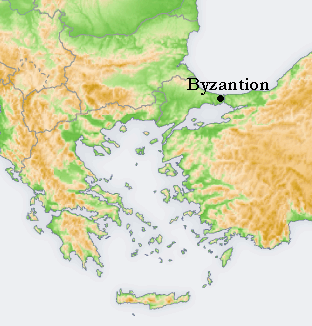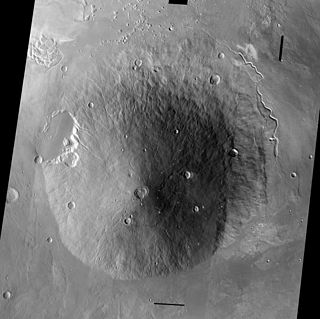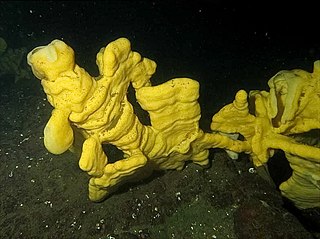
Byzantium or Byzantion was an ancient Thracian settlement and later a Greek city in classical antiquity that became known as Constantinople in late antiquity and which is known as Istanbul today. The Greek name Byzantion and its Latinization Byzantium continued to be used as a name of Constantinople sporadically and to varying degrees during the thousand year existence of the Byzantine Empire. Byzantium was colonized by Greeks from Megara in the 7th century BC and remained primarily Greek-speaking until its conquest by the Ottoman Empire in AD 1453.
Hecate is a goddess in ancient Greek religion and mythology, most often shown holding a pair of torches, a key, or snakes, or accompanied by dogs, and in later periods depicted as three-formed or triple-bodied. She is variously associated with crossroads, night, light, magic, protection from witchcraft, drugs, the Moon, graves, and ghosts. Her earliest appearance in literature was in Hesiod's Theogony in the 8th century BCE as a goddess of great honour with domains in sky, earth, and sea. She had popular followings amongst the witches of Thessaly, and an important sanctuary among the Carians of Asia Minor in Lagina. Her oldest known representation was found in Selinunte, in Sicily.

Hecate Strait is a wide but shallow strait between Haida Gwaii and the mainland of British Columbia, Canada. It merges with Queen Charlotte Sound to the south and Dixon Entrance to the north. About 140 kilometres (87 mi) wide at its southern end, Hecate Strait narrows in the north to about 48 kilometres (30 mi). It is about 260 kilometres (160 mi) in length.

The Hécate II is the standard heavy sniper rifle and anti-materiel rifle of the French Army, sometimes known as the FR-12.7. It is manufactured by PGM Précision of France. This is the largest weapon manufactured by PGM, chambered for the .50 BMG cartridge. The name of the rifle is derived from the ancient Greek goddess Hecate.

Hecates Tholus is a Martian volcano, notable for results from the European Space Agency's Mars Express mission which indicate a major eruption took place 350 million years ago. The eruption created a caldera 10 km in diameter on the volcano's western flank.

Lagina or Laginia (Λαγινία) was a town and religious centre in ancient Caria. It contained an important monumental temple of Hecate, at which great festivals were celebrated every year. For most of antiquity, it was a part of the territory of Stratonicea.

Hellboy: Blood and Iron is the second film in the Hellboy Animated series, written by Tad Stones and Mike Mignola. It first aired on March 10, 2007 on Cartoon Network, and aired again on July 19, 2008 to promote the release of Hellboy II: The Golden Army, and was released on DVD by Anchor Bay Entertainment on June 12, 2007. The film's storyline is based in part upon the Hellboy: Wake the Devil storyline from the original comics.
In Ancient Greek religion and mythology, Enodia is a distinctly Thessalian goddess, identified in certain areas or by certain ancient writers with Artemis, Hecate or Persephone. She was paired with Zeus in cult and sometimes shared sanctuaries with him. Enodia was primarily worshipped in Ancient Thessaly and was well known in Hellenistic Macedonia.
The Lampads or Lampades are the nymphs of the Underworld in Greek mythology.

The Night of Enitharmon's Joy, often referred as The Triple Hecate or simply Hecate, is a 1795 work of art by the English artist and poet William Blake which depicts Enitharmon, a female character in his mythology, or Hecate, a chthonic Greco-Roman goddess of magic and the underworld. The work presents a nightmarish scene with fantastic creatures.
In Greek mythology, Angelos or Angelia (Ἀγγελία) was a daughter of Zeus and Hera.

Ceroplesis is a genus of flat-faced longhorn beetle in the subfamily Lamiinae of the family Cerambycidae.

Ceroplesini is a tribe of longhorn beetles of the subfamily Lamiinae. It was described by Thomson in 1860.

Ceroplesis aestuans is a species of beetle in the family Cerambycidae. It was described by Olivier in 1795. It is known from Benin, Eritrea, Cameroon, Senegal, Morocco, Togo, and Uganda.

Ceroplesis calabarica is a species of beetle in the family Cerambycidae. It was described by Louis Alexandre Auguste Chevrolat in 1858. It is known from Angola, Benin, the Democratic Republic of the Congo, Cameroon, Gabon, Equatorial Guinea, Ghana, Mozambique, Nigeria, Kenya, the Republic of the Congo, Uganda, Togo, and Zambia. Its diet includes Coffea arabica and Coffea canephora.

Ceroplesis hottentotta is a species of beetle in the family Cerambycidae. It was described by Johan Christian Fabricius in 1775. It is known from South Africa. It contains the variety Ceroplesis hottentotta var. disjuncta.

Ceroplesis poggei is a species of beetle in the family Cerambycidae. It was described by Harold in 1878. It is known from Angola, the Democratic Republic of the Congo, the Republic of the Congo, Mozambique, Uganda, Tanzania, Zimbabwe, and Zambia.

Ceroplesis quinquefasciata is a species of beetle in the family Cerambycidae. It was described by Johan Christian Fabricius in 1792. It is known from Angola, the Democratic Republic of the Congo, the Central African Republic, Cameroon, the Republic of the Congo, Equatorial Guinea, Ethiopia, Saudi Arabia, South Africa, Senegal, Togo, Tanzania, Zambia, and Uganda.

Hecate Strait and Queen Charlotte Sound Glass Sponge Reefs Marine Protected Area is a 2,410-square-kilometre marine protected area located in Hecate Strait and Queen Charlotte Sound off the North Coast of British Columbia, Canada. The marine protected area was established in February 2017 with the goal of conserving the biological diversity, structural habitat, and ecosystem function of four glass sponge reefs. These reefs were the first discovered living specimens and are the largest glass sponge reefs in the world.
Gale is a minor character in Greek mythology. She was a very skillful witch who earned the wrath of Hecate, the Greek goddess of magic.














